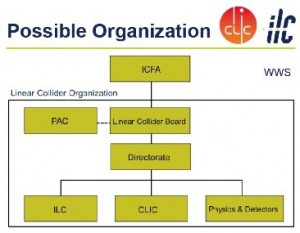We are turning the last corner towards the completion of Detailed Baseline Design (DBD), which we plan to complete at the end of the year together with the Global Design Effort’s Technical Design Report (TDR) for the ILC accelerator. In a few weeks each of the two detector groups will submit a detailed outline of its detector section, which will be monitored by the International Detector Advisory Group during the KILC12 workshop next month.
With the future achievement of these milestones in sight, the ILC Steering Committee (ILCSC) is now considering the new organisation that will lead the project beyond the TDR and DBD phase. Discussions started already in 2010 and a new scheme is being shaped into a concrete form, one whose contours became clearer last summer. The general consensus seems to be to create a new organisation for a linear collider project that includes both the ILC and CLIC programmes, in view of their individual progress and the cooperation between them. While details are yet to be worked out, the gross structure of the organisation was shown by Jon Bagger, the ILCSC chair, during LCWS11 in Granada. It is to be led by a single director who reports to a new linear collider board under the International Committee for Future Accelerators. Under the director are three structures: two for the accelerators, ILC and CLIC, and one for all physics and detector studies. While the accelerator activities remain separated with two responsible bodies, it is envisioned by the ILCSC that this is not necessary or desirable for the physics and detector side.
Accomplishing this merger of physics and detector activities is not a trivial goal. It is generally understood that the transition to the new mechanism will be made adiabatically, keeping the present structures until the atmosphere for such a merger becomes ripe. Also, such a big change requires thorough consideration by the entire community. It is desirable that the new scheme allows all the participating parties to work constructively. In order to realise such a new system, the consideration must take very many facets into account.
While it is beyond the given mandate, the joint working group between the ILC and CLIC for general detector issues is a useful contact point where ILC and CLIC colleagues can discuss this new direction. We met recently. In the short meeting, the discussion was not able go far beyond digesting the present situation, but a consensus was made that the matter must be discussed with wider participation. The joint working group may continue discussions, possibly with more members.
It is also recommended that the Worldwide Study discuss this question since it has been working for a linear collider in general. Through such considerations, we may prepare sensible inputs from a broad segment of the community for the future discussions by the ILCSC.
Just to illustrate the complexity of the question a few observations can be listed. Some features make the merger easier and others make it more complicated. There are many people who are active on both ILC and CLIC detectors since CLIC adopted the two validated ILC detector concepts. For each detector group, ILD and SiD, however, the overlap of the members between ILC and CLIC is not complete. The two colliders’ participation in detector activities is distributed differently when seen globally. The energy range and presumed timescale of ILC and CLIC accelerators are different. Thus the major physics goals can be different. This is reflected in the present objectives of R&D and simulation studies. While ILC detector groups may wish to include as much engineering studies in the post-DBD studies as they can, there will also be component R&D for both the ILC and CLIC to be continued, and some of them can be common. While both activities are international, they report to different international steering bodies now. There are also differences in organisational structure, the managing and decision-making mechanism and the phase of development.
Under such circumstances, it is a challenge to create a new mechanism that will satisfy all parties. It may require some time to deliberate and reach a good solution. But we should try hard to find one. New results from LHC may help open a new door for such considerations, too.




Recent Comments